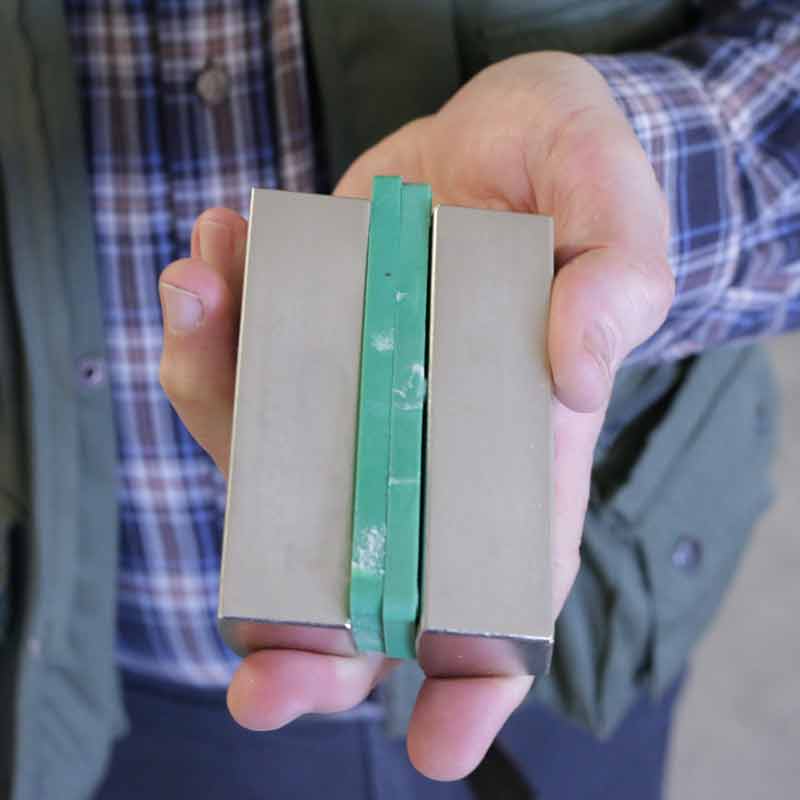Recent Post

Magnets in Restaurant Kitchens

Global supply challenges and HYAB’s role

Electromagnets – a more controllable magnet

Magnetic filtration in the process industry

Sheet metal handling – Easier with magnets
Neodymium magnets - a few health and safety precautions
Published: 2023-04-05 14:44:57 • Daniel Gårdefelt
Neodymium magnets have become more popular than ever because of the material's strong properties, and are now found in everyday applications, wherever we are. However, there are some health and safety risks with these super strong magnets. Today we will go over some precautions that can help minimize these risks.
Swallowing
One of the biggest risks with neodymium magnets is ingestion. These magnets are small and can easily be swallowed by children or pets, leading to serious health problems. If several magnets are swallowed, they can attract each other through the intestinal walls, causing blockages and harmful complications. Therefore, it is important to keep neodymium magnets out of the reach of children and pets.
Crush hazard
Neodymium magnets are incredibly strong and if not handled with care can cause serious injury. When two magnets meet, they can pinch or crush the skin and cause cuts, bruises or even more serious injuries. Therefore, it is important to handle neodymium magnets with care and wear protective gloves when necessary.
Drop / release risk
Excessively heavy lifting, material defects or fatigue can cause the magnet to undesirably release from the surface. Falling objects can cause serious injury.
* The stated strength only applies in ideal conditions. Always use a high margin of safety.
* Do not use magnets in places where there is a risk of damage in connection with material defects.
* Do not stand under objects lifted by magnets.
Electronic devices
Strong neodymium magnets can damage your electronics. The strong magnetic field of neodymium magnets can damage certain magnetic media such as credit cards, magnetic ID cards, cassette tapes and video tapes. They can also cause damage to TVs, computer monitors and other CRT displays. For smaller electronics like cell phones, iPods, calculators, and other devices that don't contain magnetic storage, there shouldn't be a problem. But just to be on the safe side, try to avoid close contact with neodymium magnets.
Pacemakers and other health risks
There are no known health risks from exposure to neodymium magnets. It can be a problem if the person has a pacemaker. An older pacemaker is more sensitive than a newer one, and you should not bring a magnet closer than 25cm from the pacemaker. A newer pacemaker is less sensitive, and has a safety distance of 20cm. (Ferrite magnets are weaker than neodymium and the magnetic field is shorter. The safety distance from a ferrite magnet is approx. 18cm). Some people actually believe that magnets can have health benefits and aid in the healing process. There are currently no scientific studies proving this. Note that large and strong magnets can cause physical damage if not handled properly.
Toxic / nickel allergy
The majority of our magnets contain nickel (even those without a nickel coating).
* Those who are allergic to nickel may have an allergic reaction when they come into contact with the magnets.
* Nickel allergies can develop from repeated contact with nickel-plated objects. Therefore avoid this.
* Avoid contact with magnets if you already have a nickel allergy.
Precautions
There are several precautions that can be taken to minimize the risks associated with neodymium magnets.
* Keep neodymium magnets out of the reach of children and pets.
* Use protective gloves when handling neodymium magnets.
* Keep neodymium magnets away from electronic devices.
* Always handle neodymium magnets with care.
Bottom line: Neodymium magnets are powerful and maybe sometimes even too powerful, and they also pose some health and safety risks that must be taken seriously. It is important to understand these risks and take appropriate precautions to minimize them.


